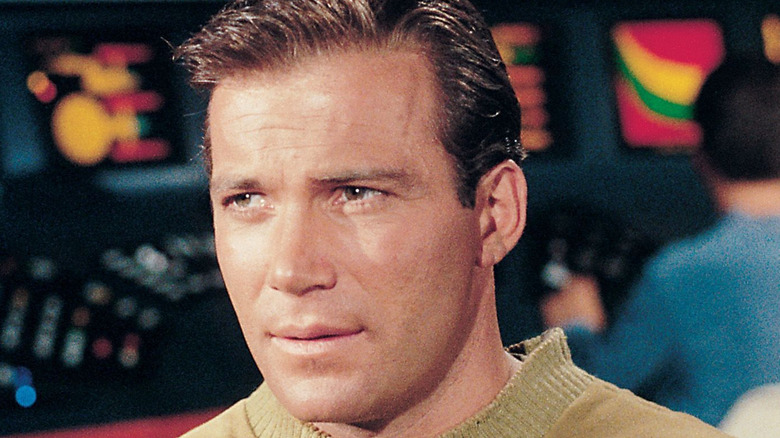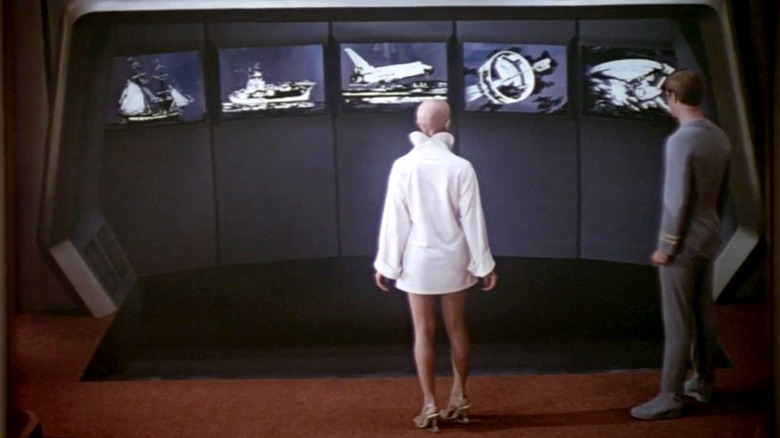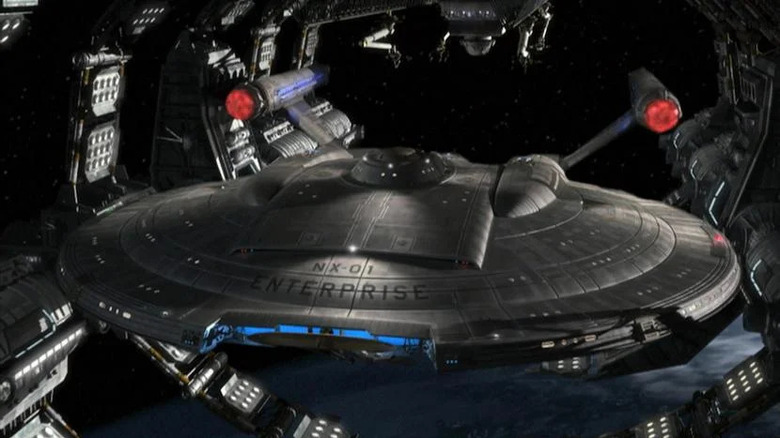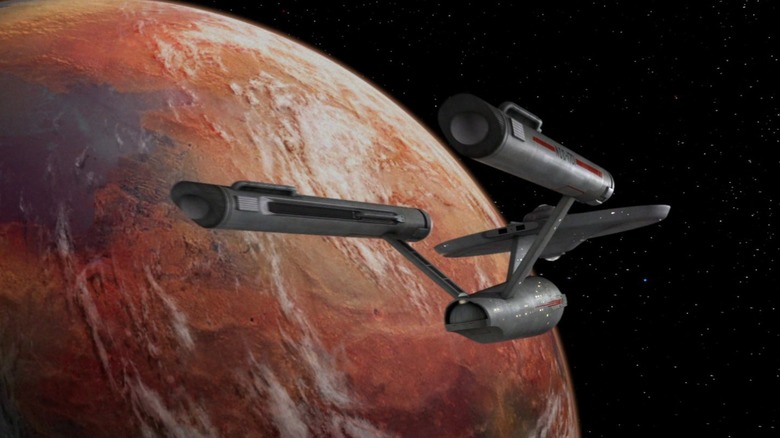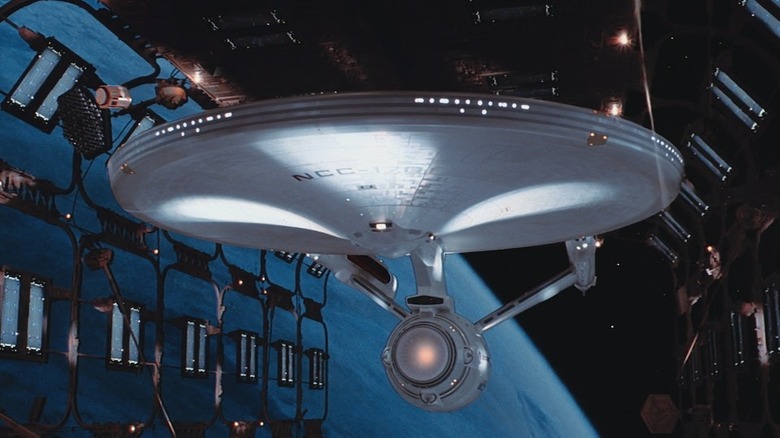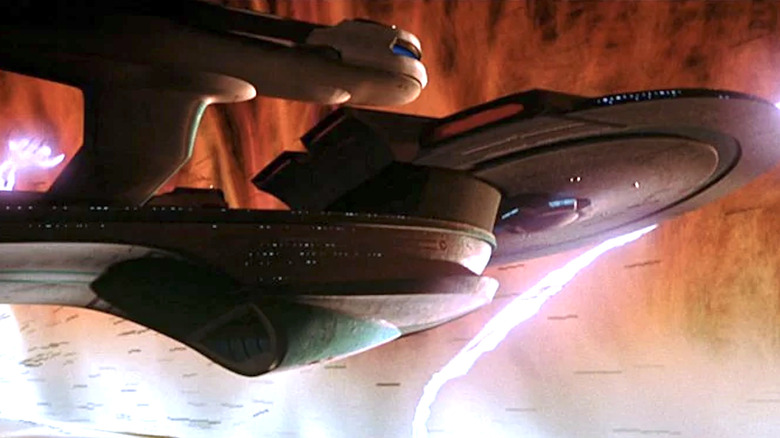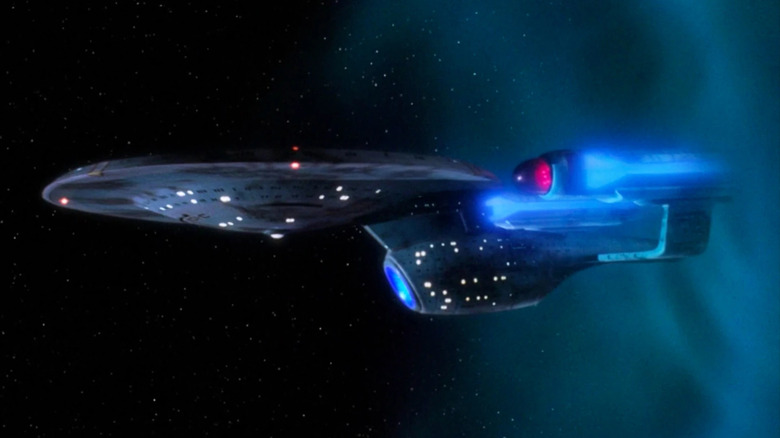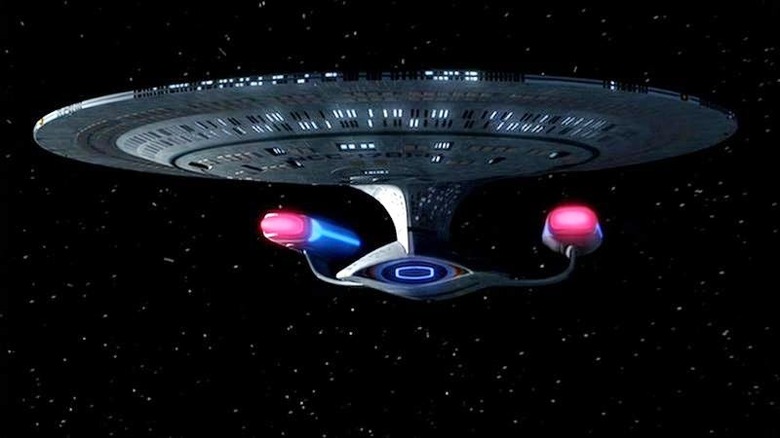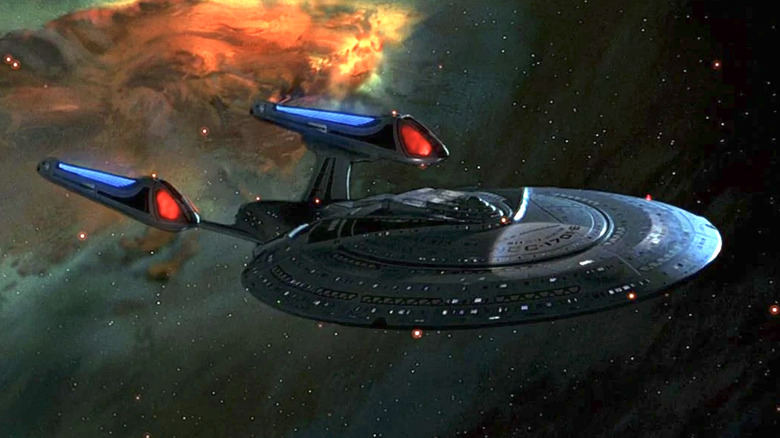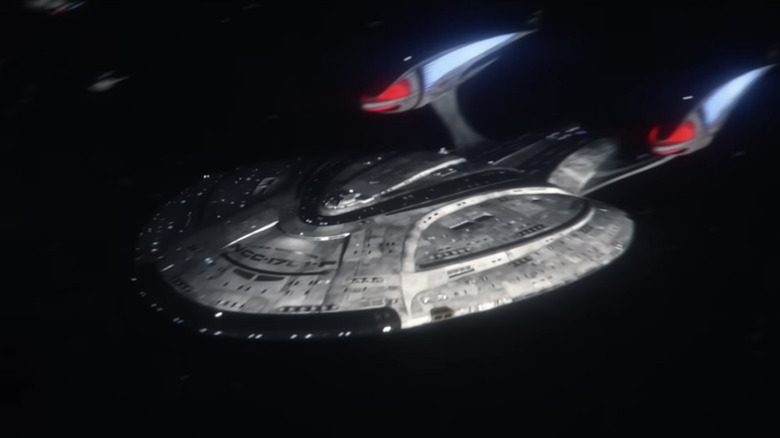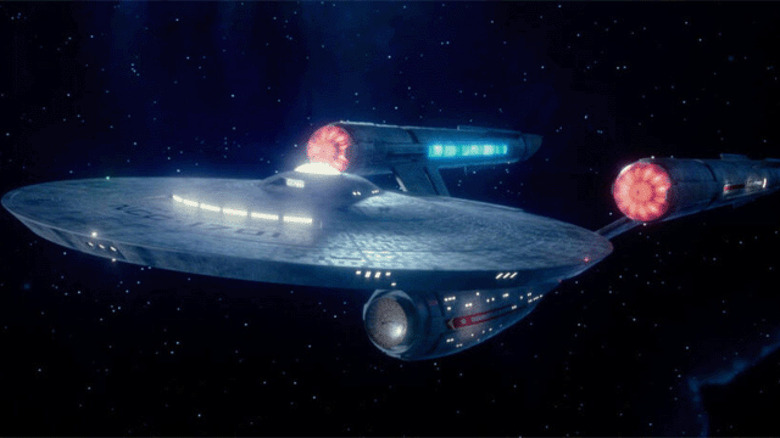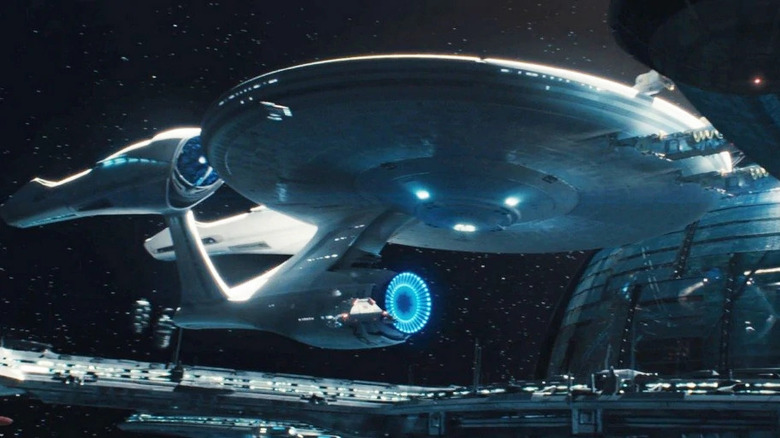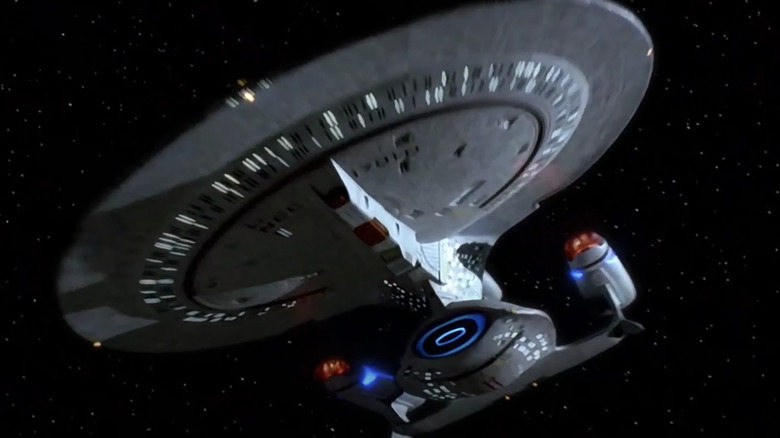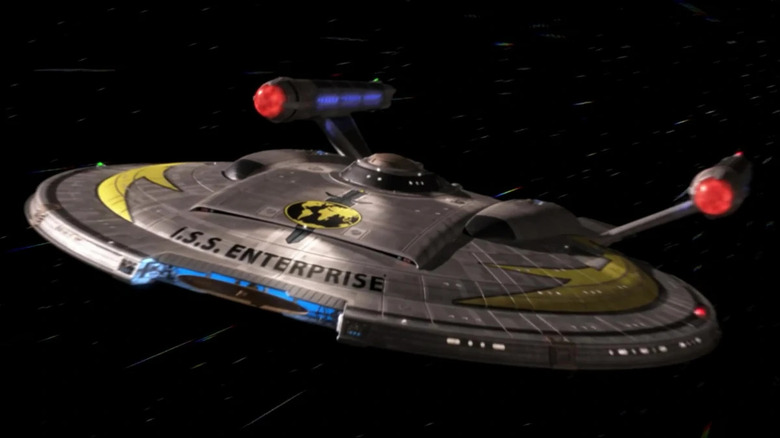The History Of The Starship Enterprise Explained
Launched in 1966 as a prime time science fiction drama, "Star Trek" has gone on to become one of the world's most famous franchises. But what made it so impactful wasn't just its compelling stories and lively characters — there's also the ship on which the series was set, the USS Enterprise. Arguably the most beloved starship in science fiction, the Enterprise — whose registry NCC-1701 is famous in its own right — has become a pop culture icon, and may be as recognized across the globe as the American flag or the McDonald's golden arches.
Since its introduction, each new era has had its own new iteration of the Enterprise: It was redesigned as the 1701-A in the feature films, and in 1987 "Star Trek: The Next Generation" introduced the Enterprise-D. By the turn of the millennium there was even a prequel spinoff named for the vessel, and in 2022, "Star Trek: Strange New Worlds" ventured back aboard the original classic starship.
With a new Enterprise-F making its debut in "Star Trek: Picard," it's time to explore the indelible legacy of the famous Federation flagship. So clear all moorings and ahead one quarter impulse power, because we're leaving space dock and setting a course to explore the history of the starship Enterprise.
Pioneering Enterprises
In the real world, there have been ships named the Enterprise as far back as the early 1700s, including the British Royal Navy's HMS Enterprize. In the United States, the world's first nuclear-powered aircraft carrier was the USS Enterprise, commissioned in 1961, which even became a key location in "Star Trek IV: The Voyage Home." The space shuttle Enterprise, meanwhile, was the first spacefaring ship to bear the name, both in "Trek" and the real world. Of course, that one was named after the "Star Trek" starship thanks to a letter-writing campaign from fans.
In the fictional world of "Star Trek," the first deep space starship to go by the name Enterprise was actually a vessel we have yet to see outside of historical images. With a registry of XCV-330, what little we know of it comes from background details, as it is seen as part of a series of images of past Enterprises in "Star Trek: The Motion Picture," as well as in Captain Forrest's office on "Enterprise." The only physical representation we have seen so far was actually in the JJ Abrams-directed "Star Trek: Into Darkness," where a model of the early Enterprise appears on the desk of Admiral Marcus.
Though little is known about this pre-Federation starship, we do know that it was based on an unused design from series artist Matt Jeffries before he settled on the Enterprise for the 1966 TV series.
Archer's first warp 5 vessel
Before the launch of "Star Trek: Enterprise" in 2001, fans had always believed that Kirk's Constitution Class Enterprise was the first Starfleet vessel to go by that name. But in a major retcon, the series introduced the NX-01, Starfleet's first flagship, proudly bearing the name Enterprise on its hull.
Earth's first-ever Warp 5 starship, its revolutionary new engine was capable of speeds never before dreamt of. The engine had been designed by Henry Archer, a protege of warp drive creator Zefram Cochrane, whose son Jonathan would become the ship's first captain. But when the engine was still in development, serious questions were raised about its readiness, and were it not for the efforts of Jonathan Archer and former rival pilot A.G. Robinson, it may have been scrapped altogether.
Launched in 2151 on a mission to deliver an injured Klingon back to his people, the NX-01 had primitive phase cannons but was without much of the advanced technology fans are familiar with from other shows, lacking energy shields, photon torpedoes, and tractor beams. The ship still managed to become legendary, serving at the forefront of the Xindi War, and was the ship Archer captained when he brought the Vulcans, Andorians, and Tellarites together to eventually form the United Federation of Planets. According to the series' finale, this Enterprise was decommissioned in 2161 and placed into a fleet museum.
Kirk's classic connie
The original USS Enterprise may not be the first one chronologically in canon, but it is the first that fans saw, and the one most people think of when they hear the name. Its groundbreaking design by concept artist Matt Jeffries combined classic sci-fi tropes — the large saucer and rocket-shaped nacelles — to form an instantly recognizable silhouette that may never be outdone.
For three years on the original "Star Trek" series, the ship traveled to strange new worlds and sought out new life and new civilizations, captained by James T. Kirk on his five-year mission to chart the edges of the final frontier. While much of its design — particularly its interior — may seem dated to today's younger audience, it lives forever in the hearts and minds of Trek fans. It was lovingly recreated for episodes of "Star Trek: The Next Generation," "Deep Space Nine," and "Enterprise," in episodes that revisited the classic Constitution Class.
A place sci-fans called home in '60s, it was aboard the original "Connie" that Trek fans first learned about phasers, photon torpedoes, and transporters. But interestingly, when it was first developed by series creator Gene Roddenberry, it was designed to be a ship with a history, and Kirk was later revealed to be the ship's third captain. In service in this form for more than two decades in-universe, it would later see a new look when "Trek" warped to the movies.
Refit for the big screen
Thanks to renewed popularity in reruns in the '70s, a revival of "Star Trek" was launched in theaters. With a bigger budget and a bigger screen, a new design for the starship Enterprise was in order, and after some radically different new concepts were considered, what would leave space dock was an updated version of the original that kept the same basic design, with some streamlined shapes and a lot more detail.
In fact, the remodel of the Enterprise serves as a major plot point in "Star Trek: The Motion Picture," which opens after an 18-month retrofit process that overhauls the starship with a nearly ground-up reconstruction. As a result, new captain William Decker objects to Kirk's reassignment to the captain's chair because of Kirk's unfamiliarity with many of the new systems. Sure enough, his lack of knowledge does wind up causing problems during the refitted Enterprise's first mission.
Eventually, this updated starship became a fan favorite in its own right. But while the refit Enterprise would meet its end in "Star Trek III: The Search for Spock," with Kirk forced to destroy the ship to stop a gang of marauding Klingons, it was replaced shortly thereafter with the USS Enterprise NCC-1701-A. Nearly identical, save for some interiors which were now redressed sets from "The Next Generation," which was then-currently airing, the Enterprise-A began a long-standing tradition of tacking on an alphabetic suffix to new starships in the line.
The successor
Following the introduction of the Enterprise-A in the 1986 film "The Voyage Home," the next ship we'd see with that name was actually the Enterprise-D, which debuted just a year later in "Star Trek: The Next Generation." We would hear nothing about the Enterprise-B until the cast of "TNG" moved to the big screen themselves, in 1994's "Star Trek: Generations."
The film that brought two eras of "Star Trek" together, it opens with the first flight of the Enterprise-B, in a ceremony attended by Captain Kirk. A state-of-the-art starship of the same class as the Excelsior seen in in "Star Trek III" — which was then under the command of Captain Sulu — this new Enterprise voyaged under the captaincy of John Harriman. Though its first mission was originally planned as little more than a trip around the solar system, it got forced into a rescue effort when a strange phenomenon threatened a nearby ship. But as it was only meant to be on a promotional tour, the Enterprise-B was without tractor beams, photon torpedoes, and medical staff.
Swinging into action, Captain Kirk saved the day and sacrificed himself to save the endangered ship. But just as many books, comics, and other media have explored the further adventures of Captain Harriman and the Enterprise-B — including its helmswoman, the daughter of Captain Sulu — we have yet to learn much more about it onscreen.
The lost warrior
Making its first appearance in the third season of "Star Trek: The Next Generation," the Enterprise-C is another ship of the line that we only ever saw once. In this case, it's in the acclaimed episode "Yesterday's Enterprise," a story that regularly ranks among the show's very best. In the episode, Picard and the Enterprise-D encounter a rift in space through which the Enterprise-C emerges, having traveled forward 22 years, altering history.
In this diverged dark timeline, the Federation is on the losing end of a decades-long war with the Klingons, and the disappearance of the Enterprise-C two decades before is a big reason why. As it turns out, the Enterprise-C — under the command of Captain Rachel Garrett — came to the aid of a Klingon outpost that was under attack, helping to smooth relations with their rivals, eventually leading to peace with the Federation.
Ultimately, after Garrett is killed in the divergent timeline, the Enterprise-C returns to the past to fulfill its destiny and restore history, but takes with it an alternate version of Tasha Yar from the Enterprise-D. Despite history recording the loss of all hands, we'd later learn that survivors from the Enterprise-C were taken prisoner on Romulus, including Yar, who would wind up giving birth to the villainous Commander Sela. Like its predecessor, what we learn in this episode is all we know officially of the Enterprise-C.
Picard's Enterprise-D
The Enterprise that led the landmark 1987 spinoff "Star Trek: The Next Generation," the 1701-D was designed by Andrew Probert, a protege of "Star Wars" concept designer Ralph McQuarrie who had been briefly hired to conceptualize the new Enterprise for the first "Star Trek" feature film. Recommended by McQuarrie to join the film's design team, Probert sketched up an early idea of for a new ship that later formed the basis for the Enterprise-D.
Nearly twice as large as Kirk's classic Enterprise, this 24th century Galaxy Class starship could go much faster, topping out at warp 9.9 (as opposed to Kirk's warp 8), and had a new feature that allowed the saucer to separate from the body of the ship during crisis. The Enterprise-D was outfitted with plenty of new technology too, including the virtual reality rooms called holodecks that have since become a "Trek" staple. It was also the first starship seen onscreen to house families, children, and schools, making it essentially an entire community on a starship. Believe it or not, the Enterprise also has a group of hyper-intelligent dolphins that help steer the ship, in a section called Cetacean Ops, that's only briefly mentioned but never seen.
Commanded by Captain Jean-Luc Picard, it was the Federation flagship seen through all seven seasons of "The Next Generation" and the crew's first feature film, "Star Trek: Generations." In the climax of that movie, the Enterprise-D crashed on Veridian III, sustaining catastrophic damage that would require its retirement from service.
A sovereign for all seasons
The first film to feature the cast of "Star Trek: The Next Generation" saw few dramatic changes during their move to cinemas. But for its follow-up, "Star Trek: First Contact," they were given a facelift: in addition to an entirely new uniform design, Picard and his crew received a new starship, the USS Enterprise-E. A Sovereign Class ship, it marked a departure from the smoother curves of the Enterprise-D and other "TNG" starships in favor of a more militant, angular design, created by illustrator John Eaves, who continued to contribute to the franchise with designs for "Star Trek: Picard" and "Star Trek: Discovery."
Upgraded with cutting-edge weapons like quantum torpedoes, the Enterprise-E went toe-to-toe with the Borg on its first adventure, during which it was partially assimilated by the cyborg collective. The Enterprise-E continued to be the hero ship in the rest of the "TNG" feature films, including "Star Trek: Insurrection" and "Star Trek: Nemesis." While the Dominion War raged, as seen on "Deep Space Nine," the Enterprise-E was held back from the front lines, instead consigned to diplomatic duties.
During its time in the films, the crew of the Enterprise-E largely remained the same as on "TNG," but the conclusion of "Nemesis" saw Riker take command of his own starship, and Picard receive a new first officer. Though we know its service continued for some years, its further adventures have never been explored officially.
The next Enterprise
When "Star Trek: Picard" premiered in 2020, it was the first time we'd seen the franchise dip its toe into the events that followed its final "TNG" feature film, and many had high hopes of seeing a new starship Enterprise. Though the first two seasons of the series didn't give the audience that gift, Trek fans finally got what they were hoping for with the third trailer for the show's third season, and the first look at the USS Enterprise-F, an all-new Odyssey Class starship.
The direct successor to Picard's Enterprise seen in the films, this new flagship is the first Enterprise to voyage in the 25th century, and while its appearance brought applause from fans, it's not actually the first time we've seen it. In fact, the Enterprise-F was first introduced as a playable starship in "Star Trek: Online," a massively multiplayer online game, in a mission simply titled "The Odyssey Class" all the way back in 2012. And what's even more remarkable is that the design of the starship was created as the winning entry of a fan contest.
The design came from a concept artist and sculptor out of Florida named Adam Ihle, and was announced as the winner in July of 2012. A natural evolution of the Sovereign Class, it's a heavy cruiser that, in the game, was developed by Starfleet to be the most powerful starship in the fleet. Now, the design is the latest successor in the Enterprise legacy onscreen, too.
Pike's flagship reborn
At the tail end of Season 2 of "Star Trek: Discovery," fans got a jaw-dropping surprise with the arrival of the classic Enterprise commanded by Captain Pike, James T. Kirk's immediate predecessor. But this was a reimagined version of the iconic starship, updated for modern audiences. Eventually, Captain Pike, Mr. Spock, and Number One got their own spinoff series, "Star Trek: Strange New Worlds," set aboard this refurbished Enterprise with a new look.
Canonically it's the same Enterprise that was commanded by Captain Kirk in the original "Star Trek" series, but this time, its differences are not the result of a refit or maintenance overhaul. Instead, producers felt it was important to update the design, inside and out, to keep up with audience expectations in the 2020s (via TrekMovie) Mixing retro futurism with 1960s interior design aesthetics, they managed to reinvigorate the original Enterprise, creating what creator Gene Roddenberry and original designer Matt Jeffries might have crafted if they'd had the budget and means back in 1966.
The biggest changes to the starship visually are its swept-back nacelle pylons, more reminiscent of the feature film refit, and the physical windows on the bridge, a feature first seen in the JJ Abrams films. While just about every aspect of the ship has been updated, set designers and artists made sure to evoke the look and feel of Kirk's original in every aspect they could. Divisive among some fans for its many changes, this new sleeker "Connie" is now the face of the 23rd century Enterprise.
JJ's ample Enterprise
In 2009 "Star Trek" and the Enterprise got a facelift when director JJ Abrams relaunched the franchise on the big screen in a total reboot of the series. The film brought "Trek" back to its roots — and back in time too, showing us an alternate timeline where younger versions of James T. Kirk and Mr. Spock, Uhura, and the rest first set foot on a newly remodeled starship Enterprise.
Redesigned from the ground up by concept artist Ryan Church — whose credentials include "Transformers" and "Avatar" — the ship has been dubbed the "JJ-prise" by fans. It kept the traditional silhouette, but featured bigger, smoother, curves and bold, bulbous, ample warp nacelles. Physically larger than the classic original, it's also much more technologically advanced, explained by the new timeline being visited by a villain from the future. It also features a clear glass viewscreen on the bridge that allows the crew to look directly into space, a major departure from previous starship designs that has since become retroactively standard, carrying over into new ships in the Prime Timeline, past and future.
Though it's initially captained by Christopher Pike, Kirk would sit in the captain's chair by the end of the first film, and command it again in its two sequels. In service through "Star Trek Beyond," the ship was damaged beyond repair by the villain Krall and replaced by a new Enterprise-A, which is seen only briefly in the film's final moments.
Enterprises of the Future
Given its science fiction nature, "Star Trek" has glimpsed into its own future more than once, and we've seen a few different Enterprises outside of the main timelines seen in the shows and movies. Some exist far off into a future we may never see onscreen, while some exist in now-erased alternate futures. In the "Star Trek: The Next Generation" finale, for example, we're introduced to a then-future version of the Enterprise-D, with a radical refit boasting three nacelles and a new, massive phaser weapon under the saucer section.
But the most notable future Enterprise might be one we never quite saw, getting only a brief look on a viewscreen in an episode of "Star Trek: Enterprise." During the Xindi War storyline, Captain Archer was pulled into the far future where time-traveling agent Daniels told him about the USS Enterprise-J, a 26th century ship that carried on the legacy more than a thousand years into Archer's future. According to Daniels, this ship was part of a battle that drove a malevolent race called the Sphere Builders back to their own realm, and in this future, it even had members of the Xindi among its crew.
Though little else is known officially about the Enterprise-J, the starship eventually made its way into the "Star Trek: Online" game, and a model was later produced by Eaglemoss. With "Star Trek: Discovery" now set in the 32nd century, we may still yet see a new version of the Enterprise even further into the future.
Alternate Enterprises
From the past and present to the far future, we've seen Enterprises of all kinds, but there are even stranger versions of the Federation flagship that have been the focus of several adventures. These variant vessels usually originate in bizarre alternate realities and parallel dimensions, and have a long history themselves. The first one seen was way back in the acclaimed 1967 episode "Mirror, Mirror" that saw the ISS Enterprise under the command of a tyrannical Captain Kirk.
That same mirror universe was revisited in a 2005 two-part episode of "Star Trek: Enterprise" which saw another ISS Enterprise, this time a variant of the NX-01, under the command of Maximillian Forrest. But Forrest is assassinated by his first officer Jonathan Archer, who takes over the ship and gets caught in a power struggle with the Vulcan T'Pol. An aged, time-ravaged alternate future NX-01 was also seen in the episode "E2."
Though "The Next Generation" never ventured into the mirror universe, we did see a more militant version of the Enterprise-D in "Yesterday's Enterprise," in a branching parallel reality created by the arrival of the Enterprise-C. In that briefly existing timeline, Picard's starship had no families, and was in fact a battle cruiser on the front lines of the war with the Klingons. Meanwhile, in the "TNG" episode "Parallels," we actually witnessed the incursion of untold numbers of Enterprises from other parallel universes, one of which had been decimated by the Borg.
